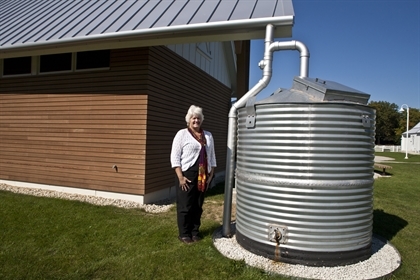
What Our Water's Worth is a campaign led by the Metropolitan Planning Council and Openlands to raise awareness about the value of water in northeastern Illinois and northwestern Indiana.
From gray to green: Investing in sustainable infrastructure

Nan Buckardt, director of environmental education and public affairs for the Lake County Forest Preserve District, surrounded by the green infrastructure of the Ryerson Woods Welcome Center. Photo by Emily Cikanek.
The Ryerson Woods Welcome Center not only greets visitors to the 500-acre Ryerson Conservation Area in unincorporated Lake County – one of the best examples of a northern flatwoods forest, a rare northern Illinois landscape – it also introduces them to development practices that save money, energy – and water.
“We were excited about making it a real showplace, but in simple ways that are commercially available to people,” says Nan Buckardt, director of environmental education and public affairs, Lake County Forest Preserve District. “It doesn’t look high-tech and ‘gee-whiz’ the way people might think a highly efficient building would look.”
Indeed, Buckardt says the Lake County Forest Preserve District planned the Welcome Center, which opened in 2006, to look like a typical nature center but function as a teaching tool for visitors. Nearly 10,000 people have toured the building to learn how to achieve energy and water efficiency.
The Platinum LEED-certified (Leadership in Energy and Environmental Design) building uses geothermal heating and cooling, recycled drywall and carpet, natural lighting, and even limestone pavers sourced from local mines. “We didn’t want to let any of our site’s stormwater into the floodplain,” says Buckardt, so they installed rain gardens and a porous parking lot to allow rain to infiltrate into the ground, rather than run off into the sewer. “Regular asphalt is like a dense brownie, and porous asphalt is like a Rice Krispie treat,” Buckardt explains, wearing her educator hat.
View a photo tour of the Ryerson Woods Welcome Center's green infrastructure.
Conservation tips
- Learn from Ryerson Woods… or Chicago’s 41st Street Beach House, Valley Forge Fieldhouse, or Harold Washington Social Security Center, all public facilities where harvested rainwater is used for toilet flushing.
- Disconnect a downspout and install a rain barrel. Managed correctly, a rain barrel will keep about 55 gallons of water out of the sewer when it rains, and then save you 55 gallons of tap water for watering your lawn and garden.
- Don’t forget the garage. In denser communities like Blue Island or Evanston, about 25 percent of the stormwater runoff from a residential property can come from the garage’s roof. Make sure to pick up an extra rain barrel!
- Choose native plants. They need less water and have long roots which help water infiltrate into the ground, saving you time and money – and preserving the region’s water supply.
Resources
- Water Reuse Handbook, Public Buildings Commission of Chicago
- WaterSense
- Water 2050 (esp. Chapter 4, pages 131-140) Northeastern Illinois Regional Water Supply/Demand Plan, Chicago Metropolitan Agency for Planning
January 2012
www.chicagolandh2o.org
The WOWW factor
100,000
Europe is way ahead of us, installing 100,000+ rainwater harvesting systems in 2005-’06 alone.
0%
Texas waives the state sales tax on rainwater harvesting systems.
140,000
That’s how many times you’ll likely flush a toilet in your lifetime.
5 gallons
Older toilets (bought before 1994) often use 5 gallons per flush, or more, while newer standard toilets use 1.6 gallons, and WaterSense toilets only 1.28.
30%
That’s roughly how much of your home’s water consumption is flushed down the toilet.
What Our Water's Worth is a monthly e-newsletter. Tell us what you think. Email info@chicagolandh2o.org with feedback in the subject.
To subscribe, visit our website at chicagolandh2o.org.

|
Metropolitan Planning Council
140 S Dearborn St | Suite 1400 | Chicago, IL 60603 Phone (312) 922-5616 phone | Fax (312) 922-5619 |
Openlands
25 E. Washington St. | Suite 1650 | Chicago, IL 60602 Phone: 312-863-6250 | Fax 312-427-6251 |
Copyright © 2025. All rights reserved. | info@chicagolandh2o.org
To stop receiving this newsletter visit metroplanning.org/unsubscribe.html?EmailMsgId=154&email=
